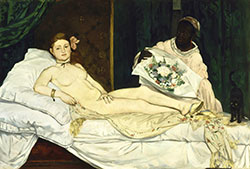Years ago I first learned of Édouard Manet’s model Victorine Meurent in Eunice Lipton’s compelling book Alias Olympia. Part biography and part memoir of her own evolution as an art historian, Lipton goes searching for the real Meurent amidst the layers of myth and mystery that surrounded this redheaded, working-class Parisian who became the scandalous subject of Manet’s most controversial canvases including “Olympia” (1863) and “Dejeuner sur l’herbe” (1863) as well as those more respectable ones such as “Young Lady in 1866” (1866) and “Saint Lazare Station” (1873). The book opens with a chapter entitled “History of an Encounter” and relates her own slow recognition of Meurent’s presence in Manet’s work. “I don’t remember when I first saw Victorine Meurent,” she begins, “but I wouldn’t have recognized her or known her name at the time. No one would have. She was just another naked woman in a painting.”
- “Manet: Portraying Life,”
Through April 14, 2013.
Royal Academy of Arts, London
The time was the 1950s, and no one would have noticed her because the acceptable questions one could ask about art weren’t directed to the women who posed naked for male painters. “One never paid attention to a painting’s literal content,” Lipton writes. That initial encounter with Meurent faded into an image both familiar and anonymous. Alias Olympia maps out a search for that “literal content” of Meurent who became more compelling for Lipton as she learned to ask different questions about art amidst the social changes of the late 1960s and 1970s.
In the late 19th century it was the encounter with such content in Manet’s paintings that often unsettled his contemporaries. Consider the patron reactions at the 1865 Paris Salon where he displayed “Odalisque,” an image of Meurent as courtesan reclining on a bed, overflowing with pale sheets and pillows surrounding her equally pale body. As a servant brings her flowers, Meurent gazes not at the bouquet but rather looks intently towards us. Unlike other such nudes, Manet portrayed his model as more than an object to be considered, but a subject who is also considering us. The critics called it indecent and grotesque. “Before anyone knew what was happening,” writes Lipton, “respectable Parisians were sweeping through the Salon’s drafty halls brandishing walking sticks and umbrellas; they were heading toward Olympia with murder on their minds.” The organizers had to cordon off the painting for fear it would be destroyed. As Lipton notes, in “Olympia,” and other paintings that present Meurent, it is her unflinching gaze that struck Manet’s contemporaries with feelings of violent unease. She was not just another nude model depicted for the pleasure of the spectator. Rather, in giving us a courtesan regarding us, Manet created a new kind of encounter between patrons and painting.
“Manet: Portraying Life,” a small but intriguing show, which opened last fall at the Toledo Museum of Art before arriving in London in January, lacks many of Manet’s well known works, including “Olympia” and a good number of his portraits (many of which are part of the recently opened “Impressionism, Fashion, and Modernity,” at Metropolitan Museum of Art in New York). But we do encounter smaller works, more acutely studied portraits and genre scenes that mix Manet’s play of realism with his distinctive sense of the painted canvas. Many of the subjects of these works are family members or close friends within Manet’s rich cultural circle. What you notice in these works is a curious tension between biography and image, and between image as biography.
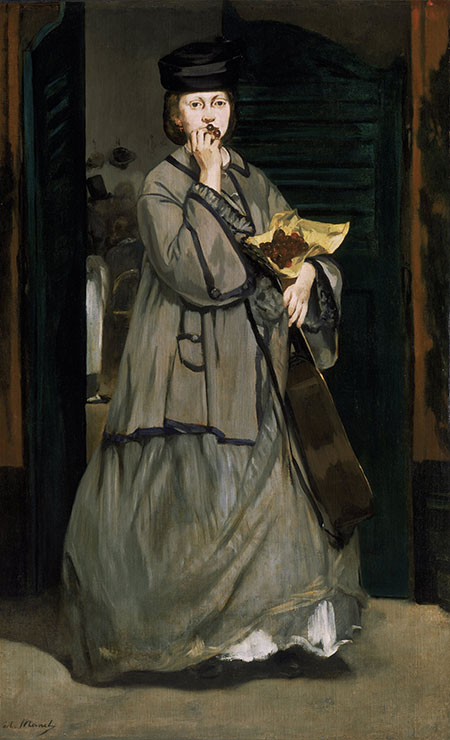
“Street Singer” (1862)
Meurent’s presence is strong here. In one of the early galleries we encounter “Street Singer” (1862) where she is presented in the guise of a musician, poised in the doorway of a café. This large canvas blurs the boundaries between portrait and street scene, casting Meurent as wondering performer, her dress dragging to the side as she clutches her guitar (the model in fact did play the guitar, but whether she was a street performer is unclear) and a small bunch of grapes, holding a cluster of them over her mouth as she gazes at us. She is caught in this moment outdoors, the darkened room behind her blurs into colors and shapes, more background than actual depth of an interior. She is a street singer only in title. We know this woman is Manet’s model created in a moment of casual encounter. Her performance is not what she does on the street, but how she appears on the canvas.
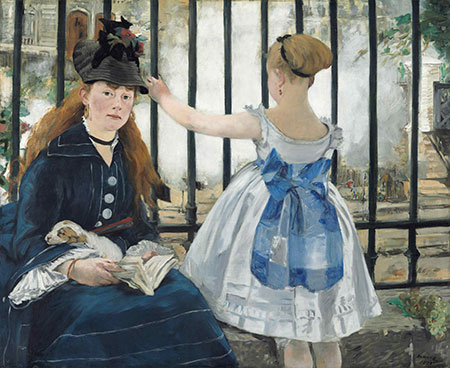
“The Railway” (1873)
Portraits of Meurent are the sole subject of the show’s last gallery, which includes a small study for Manet’s famous “Dejeuner sur l’herbe” with Meurent sitting there naked among the picnic party in the park, unconcerned with their conversation as she peers out from the contemporary scene to stare back at us. The more intriguing painting is “Saint Lazare Station” (titled in this show as “The Railway”), a quiet scene of a young girl grasping the bars of an iron fence, her back to us revealing the folds of a delicate dress and bow as she looks off into the steam of the train station beyond, while Meurent sits next to her, facing us, a small dog asleep in her lap, engaging us again with that beckoning almost challenging stare. The casualness of the moment contrasts with its acute staging. Where is the girl looking, and why does she turn from the painter’s gaze? Critics were perplexed by this painting, in what they perceived as the confusion of the canvas.
This play with composition, this mixture of everyday encounter with staged settings, threads through many of these paintings. In so many of these portraits there is a theatricality of the image, reflecting a middle-class desire to create both status and worth through their image. The invention of the carte de visite — that posed photograph done in the studio of the newly invented profession, and bought in bulk to pass out as business cards by the fashionable Parisians — are symbolic of an era when Paris transformed from Medieval hamlet to a modern city of Haussmann’s grand boulevards, majestic opera house, and the gleaming well-stocked department stores that rose not far from Manet’s studio. To be seen was not simply to be visible, but rather to project a fashionable image. Fashion itself could be considered the truer subject of many of these portraits and tableaus of Parisian life. As Manet’s close friend, the poet Charles Baudelaire claimed in The Painter of Modern Life, fashion was itself a crucial part of modernity, which he famously defined in his usual paradoxical way as “the transient, the fleeting, the contingent; it is one half of art, the other being the eternal and the immovable.”
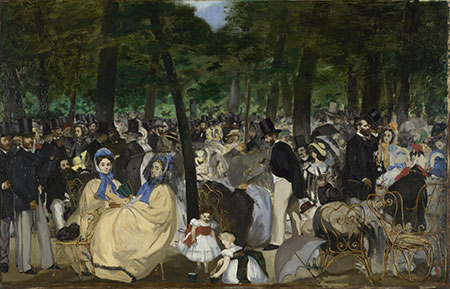
“Music in the Tuileries Gardens” (1862)
Consider Manet’s “Music in the Tuileries Gardens” (1862). In this show the painting sits alone in an echoing, darkened gallery, overhead lighting directed at the canvas making it feel as if the work itself were exuding light. It’s like approaching a small, illuminated stage in a large theater. The painting depicts a dense crowd of well-dressed Parisians, dandies in black coats and top hats, women in billowy silks and bonnets. Your eye is drawn to the two ladies seated on the left, their heads perched upon soft bundles of silk and framed by a blue bow of their hats. They stare at us, as do the men nearby, noticing us noticing them. There is little depth of this painting, as the crowd blurs into strokes of color, mixing with the flatness of the tree trunks and simple solidity of the leaves. Such techniques give the impression of movement, of a crowd caught both in place and in action. The real subjects here are those women in yellow, the rest a mere backdrop. Manet put himself here with other notable men of his cultural circle. He stands just off to the side, half in the picture frame, half out. He was of this world, born into a wealthy middle-class family. He rarely needed to sell a painting to survive. He stands here in the Tuileries both of this scene and outside of it.
It is often said that Manet invented modern painting. He challenged the limits of the canvas frame, distorting perspective and depth, framing scenes as if with the lens of a camera, such that we only get part of the scene, bodies and rooms only partly in view. He also used heavily pronounced brushwork that constantly reminds us we are looking at paint on a canvas. Look at “Portrait of Emilie Ambre as Carmen” (1880), its quick brushstrokes create feathery outlines of body and costume, creating a swirl of color and light. Her face is the most detailed part of the work, the luminous white paint conveying a theatrical light giving the opera’s singer’s face clarity and depth. He also turned his attention away from the academic demands of grand historical scenes and, like the Impressionists whom he kept at a distance, made everyday moments of middle-class Parisian life, of street encounters and Opera lobbies, bar crowds and park strollers legitimate subjects of painting. Such scenes are also quite secular, absent religious or nationalist interests. They direct their gaze at the bourgeoisie’s own individual tastes and desires. And in this way, these paintings are pure theater. They turn the life of the city into painterly scenes, making the casual in own alluring spectacle.
But beyond his use of paint and his play with the canvas frame, he did something more intriguing. He invented the modern spectator. In presenting the everyday encounters on the canvas, Manet was teaching both his subjects and his patrons ways of looking at the world around them. In depicting subjects who are so intent on regarding us, breaking the rules of painterly scenes, extending the canvas outward, Manet makes us constantly aware of ourselves looking and being looked at. Even in his more simple portraits, Manet creates us as the subjects of the painting’s gaze. We witness in these works the emergence of modernity where visual encounters so acutely defines social life. Image and biography slip into each other, turning upon one another, alluring in its play.
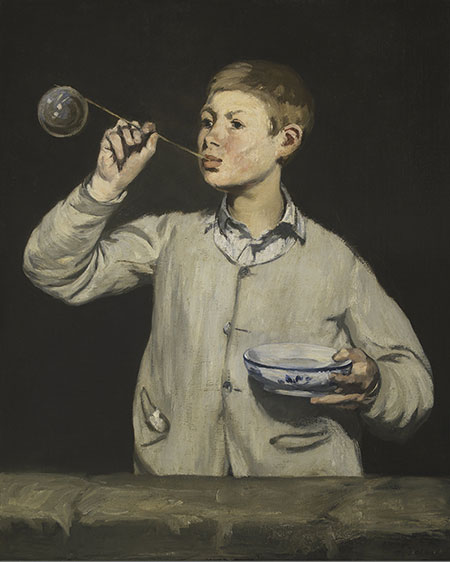
“Boy Blowing Bubbles” (1867)
Consider one of the more intriguing paintings in this show, “The Luncheon” (1868), which depicts a young man leaning against the dining table, dressed in a dark jacket and tan pants. He slouches a bit, his one hand in his pocket as he stares not at us but off into the distance beyond us. Behind him a woman, a servant perhaps, holding a silver pitcher, her gray dress blending with the wall behind her, looks with concern towards the boy. And just to the right, an older man smokes casually, looking off to his own distant concern. The table, strewn with the remnants of lunch, is oddly angled, its perspective flattened as if it is slanted towards us. But it is the boy’s contemplation we wonder about. It is the same boy as the painting hung next to it, “Boy Blowing Bubbles” (1867), a more quiet moment of earthy colors and delicate transparent light reminiscent of 17th century Northern European portraits. And again in “The Velocipede” (1871) depicting the boy riding an early, wooden bicycle along a grassy path. The painting itself fades into the canvas, unfinished at the edges, the bicycle a mere flutter of color.
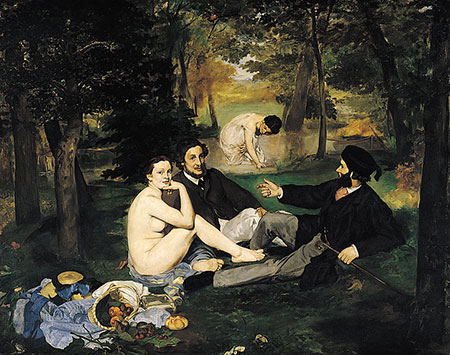
“The Luncheon on the Grass” (1862-63). Image in the public domain.
The boy is no mere model, but rather Léon-Edouard Koella Leenhoff, the son of Manet’s wife Suzanne Leenhoff. Manet and Leenhoff met when she gave piano lessons to Manet’s younger brother Eugène in 1849. Four years later she gave birth to Lèon. Suzanne was not married, and rumors of the child’s father have never been settled. Lèon’s “paternity remains uncertain” the catalog tells us and leaves it at that. His father might have been Manet’s father, August Manet, a respected court judge. It may have been Manet himself. Lèon was raised as Suzanne’s younger brother, and treated as such until just before her death in 1906 when she confessed the truth. These portraits of Lèon are not really portraits however, but remain tableaux of anonymity. Lèon is never named in any of the known portraits Manet composed of him. His image is caught in between family secret and public painting. “The Luncheon” becomes its own secret and perhaps this is why Manet gives us Lèon looking off into the distance rather than regarding us. That would be too intimate.
Just about the time Suzanne confessed the truth to her son, Meurent was admitted into the Société des Artistes Français, an independent group of artists who organized the annual Salon in Paris. In the early 20th century Meurent was living in a suburb of Paris with another woman, and recorded her occupation as artist. But Lipton never does uncover any of Meurent’s art works, just fragments of addresses, small entries in town records, objects that might have been owned by her. Together they formed a frail record of Manet’s former model. (Even in this show, the last gallery offers little about her life.) In an unpublished manuscript Lipton finds a comment about Meurent by Lèon: “when she wasn’t degraded by alcohol, she had immense charm; she was extremely alluring.” However true his comment may have been (and we have little to go on), I can’t help but think that his compliment was as much about Manet’s paintings as it was of Meurent herself. Such allure could be said of many of these works. It is the one thing about them we can know for certain. • 8 March 2013
